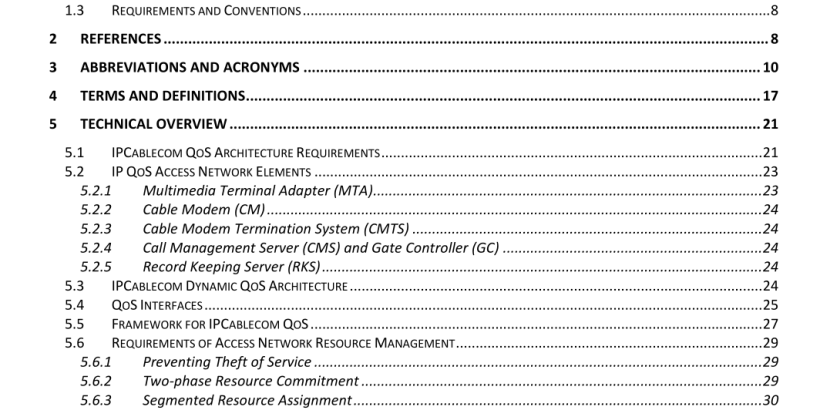ANSI SCTE 24-4-2016 pdf download.Dynamic Quality of Service for the Provision of Real-Time Services over Cable Television Networks Using Data Modems
1.1 Purpose
This standard describes a dynamic Quality-of-Service (QoS) mechanism for the IPCablecom project. It was issued to facilitate design and field-testing leading to the manufacture and interoperability of conforming hardware and software by multiple vendors. IPCablecom is a set of protocols developed to deliver Quality of Service enhanced communications services using packetized data transmission technology to a consumer’s home over the cable network. IPCablecom utilizes a network superstructure that overlays the two-way data-ready cable television network. While the initial service offerings in the IPCablecom product line are anticipated to be Packet Voice and Packet Video, the long-term project vision encompasses a large family of packet-based services.
1.2 Scope
This document addresses requirements for a client device to obtain access to IPCablecom network resources. In particular, it specifies a comprehensive mechanism for a client device to request a specific Quality of Service from the DOCSIS ® network. Extensive examples illustrate the use of the specification. The scope of this specification is to define the QoS Architecture for the “Access” portion of the IPCablecom network, provided to requesting applications on a per-flow basis. The access portion of the network is defined to be between the Multi-media Terminal Adapter (MTA) and the Cable Modem Termination System (CMTS), including the DOCSIS network. The method of QoS allocation over the backbone is unspecified in this document. Interface to the managed IP backbone and issues related to IP multicast are not within the scope of this document. This specification also recognizes that per-flow reservations may be required within the customer premises, and the protocol developed addresses this potential need.
This specification assumes that DOCSIS QoS (specifically RFI version 1.1 [9], or greater) is used to control and deliver QoS across the DOCSIS networks. Use of the term DOCSIS 1.1 is used throughout this specification and signifies any DOCSIS version 1.1 or greater. From time to time this document refers to the voice communications capabilities of an IPCablecom network in terms of “IP Telephony.” The legal/regulatory classification of IP-based voice communications provided over cable networks and otherwise, and the legal/regulatory obligations, if any, borne by providers of such voice communications, are not yet fully defined by appropriate legal and regulatory authorities. Nothing in this specification is addressed to, or intended to affect, those issues. In particular, while this document uses standard terms such as “call,” “call signaling,” “telephony,” etc., it should be recalled that while an IPCablecom network performs activities analogous to these PSTN functions, the manner by which it does so differs considerably from the manner in which they are performed in the PSTN by telecommunications carriers, and that these differences may be significant for legal/regulatory purposes. Moreover, while reference is made here to “IP Telephony,” it should be recognized that this term embraces a number of different technologies and network architecture, each with different potential associated legal/regulatory obligations. No particular legal/regulatory consequences are assumed or implied by the use of this term.
1.3 Requirements and Conventions
Throughout this document, the words that are used to define the significance of particular requirements are capitalized. These words are:This word or the adjective “REQUIRED” means that the item is an absolute requirement of this specification. This phrase means that the item is an absolute prohibition of this specification. This word or the adjective “RECOMMENDED” means that there may exist valid reasons in particular circumstances to ignore this item, but the full implications should be understood and the case carefully weighed before choosing a different course. This phrase means that there may exist valid reasons in particular circumstances when the listed behavior is acceptable or event useful, but the full implications should be understood and the case carefully weighed before implementing any behavior described with this label. This word or the adjective “OPTIONAL” means that this item is truly optional. One vendor may choose to include the item because a particular marketplace requires it or because it enhances the product, for example; another vendor may omit the same item.ANSI SCTE 24-4-2016 pdf download
